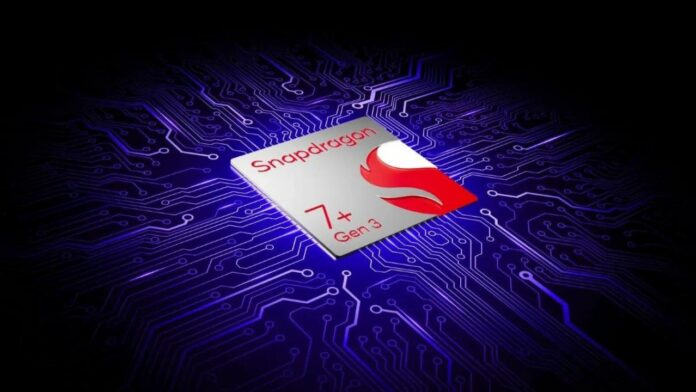Qualcomm has unveiled a new chipset post the launch of the Snapdragon 8s Gen 3. The newer chip is dubbed as the Snapdragon 7+ Gen 3 and is a premium mid-range Processor that boasts some features also seen in the chipmaker’s top-end processor, the Snapdragon 8 Gen 3. However, how does it compare to the 4 months old Snapdragon 7 Gen 3? Let’s have a look.
CPU
The new processor from Qualcomm, Snapdragon 7+ Gen 3, gets the same prime core as the Snapdragon 8s Gen 3 and the 8 Gen 3, and that’s the Cortex-X4 but with a clock speed of 2.8Ghz which is lesser than the 8 series processors. In addition, it gets 4x Cortex-A720 cores clocked up to 2.6GHz, and 3x Cortex-A520 cores clocked up to 1.9GHz.
On the other hand, the SD 7 Gen 3 doesn’t even have a prime core. It gets small and medium cores only, including a single Cortex-A715 performance core clocked at up to 2.63GHz, 3x Cortex-A715 cores clocked at 2.4GHz, and 4x Cortex-A510 cores clocked up to 1.8GHz. Note that it has four A715 cores but one of them has a higher clock speed than the other three.
The good news is that both of them are built on top of TSMC’s 4nm process which means either of them shouldn’t face any issues in terms of efficiency. However, power-wise, the SD 7+ Gen 3 is far more powerful than the 7 Gen 3.
GPU
The Snapdragon 7+ Gen 3 gets a brand new Adreno GPU that’s 45% more powerful than the one found in the Snapdragon 7+ Gen 2 as per Qualcomm’s stats. In addition, the 7+ Gen 3 GPU gets some Elite Gaming features also, which have been restricted to the Snapdragon 8 series processors until now. These include Snapdragon Game Super Resolution, Adreno Frame Motion Engine 2.0 (AFME), Game Post Processing Accelerator, HDR gaming, and Shadow Denoiser.
On the other hand, the 7 Gen 3 gets the Adreno 720 GPU which is actually inferior even when compared to the Snapdragon 7+ Gen 2. As a result, the Snapdragon 7+ Gen 3 wins in the GPU segment as well, with one of the most powerful GPUs ever been made available in a Snapdragon 7-series processor.
Storage & RAM versions
The SD 7+ Gen 3 gets you support for the latest LPDDR5x RAM and UFS 4.0 storage, same as the flagship 8 series processors. The 7 Gen 3 has LPDDR5 support for RAM and UFS 3.1 for storage, which isn’t bad, but is again less impressive than what we have for the 7+ Gen 3.
Connectivity
Connectivity-wise, the Snapdragon 7 Gen 3 from last year and the latest 7+ Gen 3, both have the Snapdragon X63 5G modem. Interestingly, Qualcomm claims that the Modem in the 7+ Gen 3 can achieve a maximum download speed of 4.2 Gbps, while the modem in 7 Gen 3 can reach up to 5 Gbps. While both of them won’t pose any issues, it’s strange to see Qualcomm downgrade in an aspect compared to the previous chip.
As for other hardware, the SD 7+ Gen 3 chip has the FastConnect 7800 system which is also found in SD 8 Gen 3. It’s equipped with support for Wi-Fi 7 with High Band Simultaneous (HBS) Multi-Link support and offers a peak speed of up to 5.8 Gbps. The chipset also supports Bluetooth v5.4, and LE Audio. The 7 Gen 3 gets a generation old FastConnect 6900 system, which offers Wi-Fi 6E with speeds of up to 3.6 Gbps, along with Bluetooth v5.3 and LE Audio.
ISP
Now, we come to the Image Signal Processor which is responsible for handling the optics of a smartphone. The ISP on the Snapdragon 7+ Gen 3 is actually quite identical to that of the Snapdragon 8s Gen 3. It gets triple 18-bit ISPs and supports features like real-time semantic segmentation for both photos and videos (up to 12 layers), support for all types of HDR image sensors, Google Ultra HDR photo capture, Dolby Vision shooting format, AI-powered video shooting features and much more. Besides, it capture photos up to 200 MP, and record 4K HDR videos at 60 FPS. There is also support for Bokeh Engine 2.0 for videos along with Snapdragon Low Light Vision (LLV).
The triple 12-bit ISPs of the 7 Gen 3 can also capture photos up to 200MP, and record 4K HDR videos at 60 FPS. However, it only gets support for the older Bokeh Engine 1.0 for videos.
The newer ISP with better features and upgraded hardware definitely help the 7+ Gen 3 in becoming the best 7 series chipset in terms of optics.
NPU
Finally, NPU is where the Snapdragon 7+ Gen 3 shines even more. It packs the Hexagon NPU which can now run AI models locally on the device itself. Smaller AI models such as Baichuan-7B, Llama 2, and Gemini Nano are all supported, similar to the Snapdragon 8s Gen 3. On the other hand, the
7 Gen 3 also has the Hegaxon Engine but its not powerful enough to support on-device generative AI capabilities.
Verdict
The Snapdragon 7+ Gen 3 is one beast of a chip according to its on-paper specs. It gets all the things right and is fairly more powerful and capable than the Snapdragon 7 Gen 3, making it a significant upgrade. The OnePlus Ace 3V is the first smartphone to be powered by the Snapdragon 7+ Gen 3 and we expect more brands to follow. The chipset should make an appearance in sub-Rs 35,000 segment in India.


